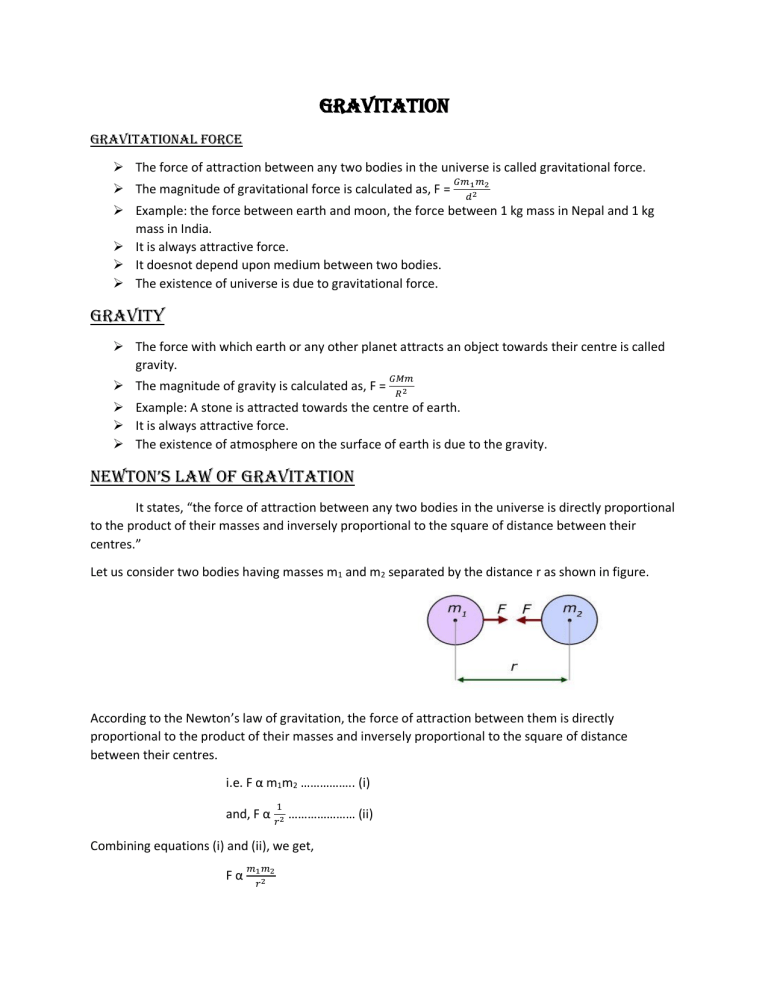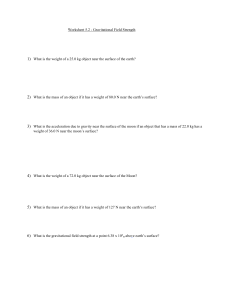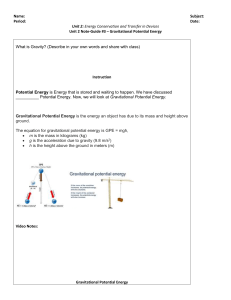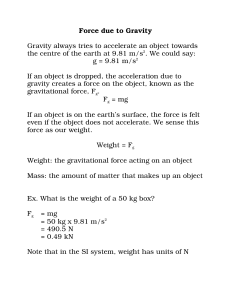
Gravitation Gravitational force The force of attraction between any two bodies in the universe is called gravitational force. The magnitude of gravitational force is calculated as, F = 𝐺𝑚1 𝑚2 𝑑2 Example: the force between earth and moon, the force between 1 kg mass in Nepal and 1 kg mass in India. It is always attractive force. It doesnot depend upon medium between two bodies. The existence of universe is due to gravitational force. Gravity The force with which earth or any other planet attracts an object towards their centre is called gravity. The magnitude of gravity is calculated as, F = 𝐺𝑀𝑚 𝑅2 Example: A stone is attracted towards the centre of earth. It is always attractive force. The existence of atmosphere on the surface of earth is due to the gravity. NewtoN’s law of gravitatioN It states, “the force of attraction between any two bodies in the universe is directly proportional to the product of their masses and inversely proportional to the square of distance between their centres.” Let us consider two bodies having masses m1 and m2 separated by the distance r as shown in figure. According to the Newton’s law of gravitation, the force of attraction between them is directly proportional to the product of their masses and inversely proportional to the square of distance between their centres. i.e. F α m1m2 …………….. (i) 1 and, F α 𝑟2 ………………… (ii) Combining equations (i) and (ii), we get, Fα 𝑚1 𝑚2 𝑟2 Or, F = 𝐺𝑚1 𝑚2 𝑑2 Where, G is proportionality constant called universal gravitational constant. Its value is 6.67 x 10-11Nm2/kg2. Inertial mass and gravitational mass Inertial mass 1. The mass of a body when it is in motion is called inertial mass. 2. It is calculated when the body has some has acceleration. 3. It is calculated by, F = ma Gravitational mass 1. The mass of a body when it is at rest is called gravitational mass. 2. It is calculated when the body is at rest. 𝐺𝑀𝑚 3. It is calculated by, F = 2 𝑅 Mass and Weight Mass 1. The amount of matter contained in a body is called mass 2. It is always constant. 3. It is a scalar quantity. 4. Its value cannot be zero. Weight 1. The force with which earth or any other planets attract an object towards their centre is called weight. 2. It varies from place to place. 3. It is a vector quantity. 4. Its value can be zero. Gravitational field intensity The gravitational field intensity at a point in the gravitational field is defined as the force experienced by unit mass at that point. 𝐹 It is calculated as, E = 𝑚 = 𝐺𝑀𝑚 𝑚𝑅 2 = 𝐺𝑀 𝑅2 Its unit is N/kg It is numerically equal to the acceleration due to gravity. Acceleration due to gravity The acceleration produced on a freely falling body due to gravity is called acceleration due to gravity. Its value changes from place to place. For the earth, acceleration due to gravity is maximum at pole. Its value is calculated as, g = It is a vector quantity. 𝐺𝑀 𝑅2 Variation of acceleration due to gravity (A) Variation of acceleration due to gravity due to height The acceleration due gravity at the surface of earth is given by, g= 𝐺𝑀 𝑅2 …………………. (i) The value of acceleration due to gravity at the height ‘h’ from the surface of earth is, 𝐺𝑀 g’ = (𝑅+ℎ)2 ……………. (ii) Dividing equation (ii) by (i), we get, 𝑔′ 𝑔 = 𝐺𝑀 (𝑅+ℎ)2 X 𝑅2 𝐺𝑀 𝑅2 = (𝑅+ℎ)2 =( 𝑅+ ℎ −2 𝑅 ) ℎ −2 = (1 + 𝑅) Expanding RHS using Binomial expansion, we get, 𝑔′ =1- 𝑔 2ℎ 𝑅 + higher power terms of h/R The value of h/R is very small and its higher power terms can be neglected. So, 𝑔′ =1- 𝑔 2ℎ 𝑅 2ℎ g’ = g(1 - 𝑅 ) This relation shows that the acceleration due to gravity decreases with increase in height from the earth surface. (B) Variation of acceleration due to gravity due to depth The acceleration due to gravity at the surface of earth is, 𝐺𝑀 g= 2 = 𝑅 𝐺 x 𝑉 x𝜌 = 𝑅2 4 𝐺 x 𝜋𝑅 3 x𝜌 3 𝑅2 4 Or, g = 3πRρG …………. (i) Similarly, the acceleration due to gravity at a depth x from the surface of earth is, 4 g’ = 3π(R – x)ρG ……………. (ii) Dividing equation (ii) by equation (i). we get 𝑔′ 𝑔 4 =3 = π(R−x)ρG 4 πRρG 3 𝑅−𝑥 𝑅 𝑥 g’ = g (1 - 𝑅) This relation shows that the acceleration due to gravity decreases with increase in depth from the earth’s surface. Q. If a man can lift 60 kg mass on the surface of earth, the mass he can lift on the surface of moon is ……360kg(For a person, mege = mmgm or, 60 x 6gm = mm gm or, mm = 360Kg) Q. If a man can lift 60 N load on the surface of earth, the load he can lift on the surface of moon is…….60N (For a person, mege = mmgm = 60N ) Q. If the mass of man is 60 kg on the surface of earth, his mass on the surface of moon is………60Kg Q. If the weight of a man is 60N on the surface of earth, his weight on the surface of moon is………….10N ( m = 6 kg, for moon, w = mxgm = 6 x ge/6 = 10N) Q. If a man can lift 60 N load on the surface of earth, the mass he can lift on the surface of moon is………36kg Q. If the potential energy of a man is 60J on the surface of earth, his potential energy on the surface of moon is…….60J Q. If a man can jump 1m on the surface of earth, the height he can jump on the surface of moon is………..6m Gravitational potential The amount of work done in bringing a body of unit mass from infinity to a point in the gravitational field of earth is called gravitational potential. The gravitational force between the earth and the body of unit mass at point P at a distance x from the earth is, F= 𝐺𝑀𝑚 𝑥2 or, F = 𝐺𝑀 𝑥2 The small amount of work done in bringing a body from point P to Q through small distance dx is, dw = Fdx = 𝐺𝑀 𝑥2 dx The total work done in bringing the body from infinity to the point A is, 𝑟 w = ∫∞ 𝑑𝑤 𝑟 𝐺𝑀 = ∫∞ = = = dx 𝑥2 𝑟 GM∫∞ 𝑥 −2 𝑑𝑥 𝑥 −2+1 𝑟 ] GM [ −2+1 ∞ 1 𝑟 - GM[𝑥 ] ∞ 1 1 = - GM [𝑟 − ∞] = −𝐺𝑀 𝑟 This work done is equal to the gravitational potential at point A. So, Gravitational potential, V = −𝐺𝑀 𝑟 (∫ 𝑥 𝑛 𝑑𝑥 = [ 𝑥 𝑛+1 𝑛+1 ]) Gravitational potential energy The amount of work done in bringing a body of unit mass from infinity to a point in the gravitational field of earth is called gravitational potential. The gravitational force between the earth and the body of unit mass at point P at a distance x from the earth is, F= 𝐺𝑀𝑚 𝑥2 or, F = 𝐺𝑀 𝑥2 The small amount of work done in bringing a body from point P to Q through small distance dx is, dw = Fdx = 𝐺𝑀 𝑥2 dx The total work done in bringing the body from infinity to the point A is, 𝑟 w = ∫∞ 𝑑𝑤 𝑟 𝐺𝑀𝑚 = ∫∞ = = = 𝑥2 dx 𝑟 GMm∫∞ 𝑥 −2 𝑑𝑥 𝑥 −2+1 𝑟 ] GMm [ −2+1 ∞ 1 𝑟 - GMm[𝑥 ] ∞ 1 1 = - GMm [𝑟 − ∞] (∫ 𝑥 𝑛 𝑑𝑥 = [ 𝑥 𝑛+1 𝑛+1 ]) w = −𝐺𝑀𝑚 𝑟 This work done is equal to the gravitational potential energy at point A. So, Gravitational potential energy, U = −𝐺𝑀𝑚 𝑟 Escape velocity Escape velocity is the minimum velocity required by a body to be projected to overcome the gravitational pull of the earth. The gravitational force between the earth and the body of at point P at a distance x from the earth is, F= 𝐺𝑀𝑚 𝑥2 The small amount of work done in moving a body from point P to Q through small distance dx is, dw = Fdx = 𝐺𝑀𝑚 𝑥2 dx The total work done in moving the body from surface of earth (point A) to the infinity is, ∞ w = ∫𝑅 𝑑𝑤 ∞ 𝐺𝑀𝑚 = ∫𝑅 = = GMm 𝑥 −2+1 ∞ [ ] −2+1 𝑅 𝑥2 dx ∞ GMm∫𝑅 𝑥 −2 𝑑𝑥 𝑥 𝑛+1 (∫ 𝑥 𝑛 𝑑𝑥 = [ 𝑛+1 ]) 1 = - GMm[ ] ∞ 𝑅 𝑥 1 1 = - GMm [∞ − 𝑅] w = 𝐺𝑀𝑚 𝑅 This work done is equal to the kinetic energy of a moving body. i.e. K.E. = w or, or, or, Since, g = 1 2 𝑚𝑣𝑒2 = 𝑣𝑒2 = 𝐺𝑀𝑚 2𝐺𝑀 ve = √ 𝑅 (ve is escape velocity of earth) 𝑅 2𝐺𝑀 𝑅 …………………… (i) 𝐺𝑀 𝑅2 ve = √ 2𝑔𝑅 2 𝑅 So, ve = √2𝑔𝑅 This is an expression for escape velocity. For earth, g = 9.8ms-2 R = 6400000m Then, ve = √2𝑔𝑅 = √2 x 9.8x 6400000 = 11.2km/s Satellite A satellite is a body that orbits around another body in space. Satellites can be natural or artificial. The gravitational pull provides necessary centripetal force for the satellite. satellites donot require any types of fuel to move in a circular path. Geostationary satellite A satellite which appears stationary above the surface of earth is called geostationary satellite. The time period of geostationary satellite is 24 hrs. The height of geostationary satellite is 36000 km from the surface of earth. The radius of orbit of geostationary satellite is 42400 km. Orbital velocity The velocity which causes the satellite to revolve around the earth (planet) is called orbital velocity. Consider a satellite of mass m revolving around the earth at a height h from the surface of earth. The radius of orbit of satellite is (R+h). The gravitational pull of earth provides necessary centripetal force for the satellite. i.e. 𝑚𝑣 2 𝐺𝑀𝑚 (𝑅+ℎ)2 = 𝑅+ℎ𝑜 𝐺𝑀 or, vo2 = or, v0 = √𝑅+ℎ 𝑅+ℎ 𝐺𝑀 This is an expression of orbital velocity. If the satellite is close to the surface of earth then, R+h ≈ R So, v0 = √ 𝐺𝑀 𝑅 v0 = √ 𝑔𝑅 2 (g = 𝑅 𝐺𝑀 𝑅2 ) Hence, v0 = √𝑔𝑅 For earth, g = 9.8ms-2 and R = 6400000m So, v0 = √9.8 x 6400000 ≈ 7.91 km/s Time period of satellite The time period of satellite is given by, Time period, T = 2𝜋 𝜔 = = 2𝜋𝑟 𝑣𝑜 2𝜋(𝑅+ℎ) √ (v = ωr) 𝐺𝑀 𝑅+ℎ = 2π√ (𝑅+ℎ)3 𝐺𝑀 Energy of satellite The satellite moving around the earth possess both potential energy and kinetic energy. So, the total energy of satellite is equal to the sum of potential energy and kinetic energy. The potential energy of satellite is given by, −𝐺𝑀𝑚 P.E. = 𝑅+ℎ ………………. (i) The kinetic energy of satellite is given by, 1 K.E. = 2 𝑚𝑣𝑜2 2 1 𝐺𝑀 = 2 𝑚 (√𝑅+ℎ ) K.E. = 𝐺𝑀𝑚 2(𝑅+ℎ) ……………. (ii) Now, the total energy of satellite is, E = P.E. + K.E. = −𝐺𝑀𝑚 𝑅+ℎ − 𝐺𝑀𝑚 𝐺𝑀𝑚 + 2(𝑅+ℎ) E = 2(𝑅+ℎ) This gives the total energy of satellite.







